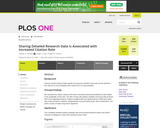
Background. Attribution to the original contributor upon reuse of published data is important both as a reward for data creators and to document the provenance of research findings. Previous studies have found that papers with publicly available datasets receive a higher number of citations than similar studies without available data. However, few previous analyses have had the statistical power to control for the many variables known to predict citation rate, which has led to uncertain estimates of the “citation benefit”. Furthermore, little is known about patterns in data reuse over time and across datasets. Method and Results. Here, we look at citation rates while controlling for many known citation predictors and investigate the variability of data reuse. In a multivariate regression on 10,555 studies that created gene expression microarray data, we found that studies that made data available in a public repository received 9% (95% confidence interval: 5% to 13%) more citations than similar studies for which the data was not made available. Date of publication, journal impact factor, open access status, number of authors, first and last author publication history, corresponding author country, institution citation history, and study topic were included as covariates. The citation benefit varied with date of dataset deposition: a citation benefit was most clear for papers published in 2004 and 2005, at about 30%. Authors published most papers using their own datasets within two years of their first publication on the dataset, whereas data reuse papers published by third-party investigators continued to accumulate for at least six years. To study patterns of data reuse directly, we compiled 9,724 instances of third party data reuse via mention of GEO or ArrayExpress accession numbers in the full text of papers. The level of third-party data use was high: for 100 datasets deposited in year 0, we estimated that 40 papers in PubMed reused a dataset by year 2, 100 by year 4, and more than 150 data reuse papers had been published by year 5. Data reuse was distributed across a broad base of datasets: a very conservative estimate found that 20% of the datasets deposited between 2003 and 2007 had been reused at least once by third parties. Conclusion. After accounting for other factors affecting citation rate, we find a robust citation benefit from open data, although a smaller one than previously reported. We conclude there is a direct effect of third-party data reuse that persists for years beyond the time when researchers have published most of the papers reusing their own data. Other factors that may also contribute to the citation benefit are considered. We further conclude that, at least for gene expression microarray data, a substantial fraction of archived datasets are reused, and that the intensity of dataset reuse has been steadily increasing since 2003.
- Subject:
- Applied Science
- Information Science
- Life Science
- Social Science
- Material Type:
- Reading
- Provider:
- PeerJ
- Author:
- Heather A. Piwowar
- Todd J. Vision
- Date Added:
- 08/07/2020
